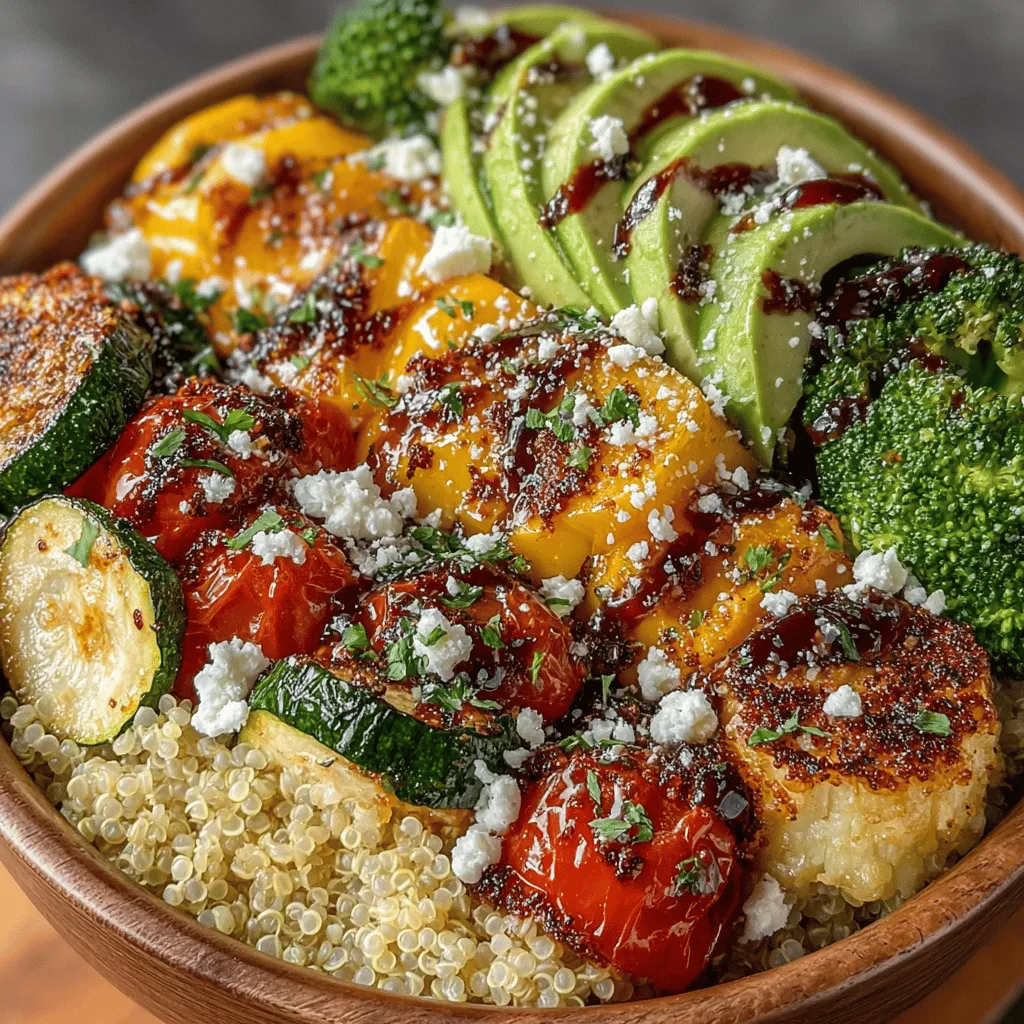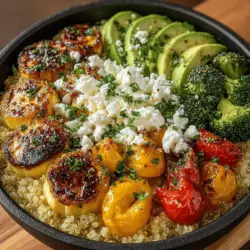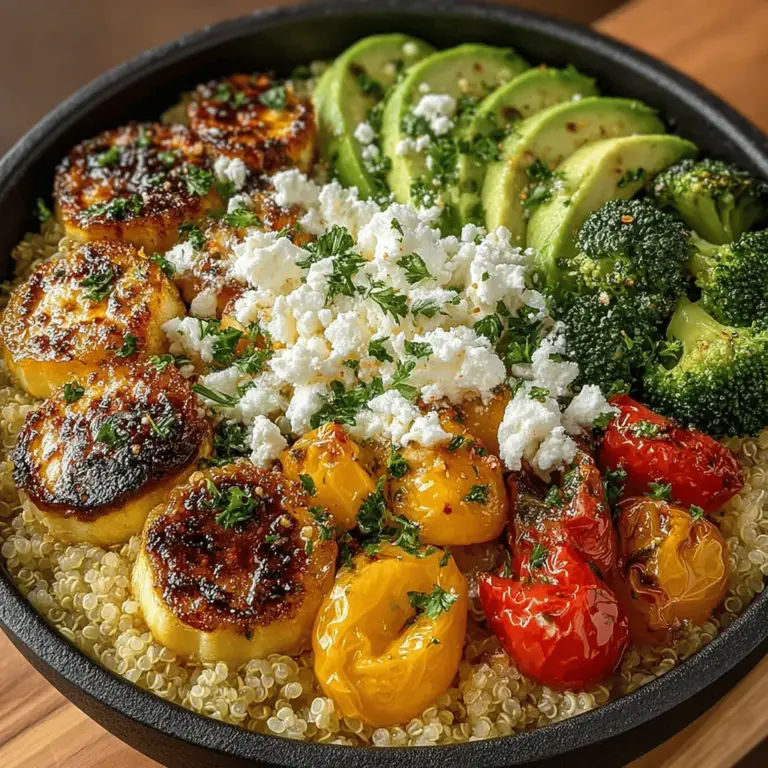Quinoa and Roasted Veggie Power Bowls: A Wholesome Introduction
In recent years, there has been a significant shift towards plant-based meals, as more individuals are becoming aware of the benefits of incorporating more fruits, vegetables, grains, and legumes into their diets. This trend is not merely a dietary choice; it’s a lifestyle embraced by many for health, environmental, and ethical reasons. One dish that has gained immense popularity in this culinary movement is the power bowl—a vibrant, nutrient-packed meal that combines various wholesome ingredients into one satisfying serving.
At the heart of our Quinoa and Roasted Veggie Power Bowls is quinoa, a remarkable seed that has earned its reputation as a superfood. Originating from the Andean region of South America, quinoa has been cultivated for thousands of years and was considered a staple food by the Incas. What sets quinoa apart is its impressive nutritional profile; it is loaded with protein, fiber, vitamins, and essential minerals, making it an ideal foundation for a balanced meal.
In addition to quinoa, this recipe showcases the benefits of roasted vegetables. Roasting not only enhances the natural flavors and textures of vegetables but also brings out their sweetness, making them even more appealing. The combination of these two components results in a dish that is not only visually stunning but also packed with nutrients.
The appeal of the Quinoa and Roasted Veggie Power Bowls lies in their health benefits, versatility, and ease of preparation. Whether you’re looking for a quick lunch, a hearty dinner, or a meal prep option for the week ahead, this recipe fits the bill perfectly. It can be customized with your favorite vegetables or proteins, making it a flexible option for various dietary preferences.
Understanding Quinoa: A Nutritional Powerhouse
Quinoa (Chenopodium quinoa), often mistaken for a grain, is actually a seed that belongs to the same family as spinach and beets. This ancient crop has been revered for its health benefits and is often dubbed a “superfood” due to its impressive nutrient density. Quinoa is one of the few plant foods that is considered a complete protein, meaning it contains all nine essential amino acids that our bodies cannot produce on their own. This makes it an excellent choice for vegetarians and vegans looking for high-quality protein sources.
In terms of nutrition, quinoa is rich in fiber, which aids in digestion and helps keep you feeling full longer. It is also a good source of B vitamins, iron, magnesium, phosphorus, potassium, and antioxidants. These nutrients contribute to overall health by supporting various bodily functions, including energy production, immune function, and bone health.
When compared to other grains such as rice or wheat, quinoa stands out due to its superior protein content and lower glycemic index. This means that quinoa can provide sustained energy without causing spikes in blood sugar levels, making it a smart choice for those managing their weight or blood sugar.
When selecting quinoa, look for organic options if possible, as this ensures that it has been grown without harmful pesticides or chemicals. Quinoa can be found in various colors, including white, red, and black, each offering a slightly different flavor and texture. Storing quinoa is simple; keep it in an airtight container in a cool, dry place, and it can last for several months.
The Versatility of Roasted Vegetables
Roasting vegetables is a cooking technique that has gained popularity for good reason. This method enhances the natural flavors and brings out the sweetness of the vegetables, making them more enjoyable to eat. The high heat of roasting caramelizes the sugars in the vegetables, resulting in a rich, savory taste that pairs beautifully with the nutty flavor of quinoa.
In our Quinoa and Roasted Veggie Power Bowls, we will focus on a selection of vibrant, nutrient-dense vegetables, including zucchini, bell peppers, cherry tomatoes, red onions, and broccoli. Each of these vegetables not only adds a burst of color to the dish but also contributes unique nutritional benefits.
– Zucchini is low in calories and high in water content, making it an excellent choice for hydration. It is also a good source of vitamins A and C, which are essential for maintaining healthy skin and immune function.
– Bell peppers, available in various colors, are rich in vitamin C, which is crucial for collagen production and a healthy immune system. They also contain antioxidants that help combat oxidative stress in the body.
– Cherry tomatoes are packed with lycopene, a powerful antioxidant that has been linked to numerous health benefits, including heart health and reduced risk of certain cancers. Their natural sweetness adds a delightful contrast to the other roasted vegetables.
– Red onions are not only flavorful but also contain quercetin, a potent antioxidant known for its anti-inflammatory properties. They can also help regulate blood sugar levels and support heart health.
– Broccoli is a nutrient powerhouse, rich in vitamins K and C, fiber, and various antioxidants. It supports digestion and is associated with numerous health benefits, including improved heart health and reduced inflammation.
When selecting vegetables for roasting, consider seasonal options to ensure the freshest flavors and maximum nutrient density. Seasonal vegetables are often more affordable and can enhance the overall taste of your power bowls.
Recipe Breakdown: Quinoa and Roasted Veggie Power Bowls
Now that you understand the key components of our dish, let’s dive into the recipe structure and preparation steps. The Quinoa and Roasted Veggie Power Bowls are straightforward to prepare, making them an excellent option for both novice cooks and seasoned chefs.
Ingredients
To create these delicious power bowls, you will need the following ingredients, each chosen for its unique flavor and nutritional benefits:
– Quinoa: The star of the dish, providing a hearty base that is both filling and nutritious.
– Vegetable broth or water: While you can cook quinoa in plain water, using vegetable broth will infuse it with additional flavor, enhancing the overall taste of the power bowls.
– Zucchini: Cut into bite-sized pieces for even roasting.
– Bell peppers: Any color will work; chop them into strips for a colorful addition.
– Cherry tomatoes: Halved for easy roasting.
– Red onion: Sliced into wedges to add a savory kick.
– Broccoli: Cut into florets to ensure even cooking.
By combining these ingredients, you’ll create a nutrient-rich, satisfying meal that can stand alone or serve as a side dish. In the subsequent sections of this article, we will explore the detailed preparation steps, cooking instructions, and tips for customizing your power bowls to suit your tastes. Stay tuned to discover how to transform these wholesome ingredients into a delicious, nourishing meal that’s perfect for any occasion.

Choice of Vegetables and Seasoning
When it comes to creating your quinoa and roasted veggie power bowls, the choice of vegetables is crucial for both flavor and nutrition. Root vegetables like sweet potatoes, carrots, and beets offer a natural sweetness when roasted, while cruciferous vegetables such as broccoli, Brussels sprouts, and cauliflower add a hearty texture and robust flavor. Bell peppers and zucchini provide a fresh, vibrant crunch, and cherry tomatoes can add a delightful burst of juiciness.
For seasoning, consider a blend of olive oil, salt, and pepper as your base. You can elevate the flavor profile further by incorporating spices such as garlic powder, paprika, cumin, or even a sprinkle of cayenne pepper for a kick. Fresh herbs like rosemary, thyme, or basil can also enhance the overall taste of your dish, bringing freshness and brightness to your power bowl.
Optional Ingredients for Customization
One of the best features of power bowls is their versatility. You can customize them to suit your taste preferences or dietary needs. Consider adding grains like farro, bulgur, or brown rice if you want to diversify the base. For an extra protein boost, toss in chickpeas, black beans, or lentils. If you’re a meat lover, grilled chicken or shrimp can be excellent additions. For those on a vegan or vegetarian diet, opt for tofu, tempeh, or nutritional yeast for a cheesy flavor without the dairy.
Step-by-Step Cooking Instructions
Preheating the Oven: Importance of Temperature for Roasting
Begin by preheating your oven to 425°F (220°C). This high temperature is crucial for achieving perfectly roasted vegetables. Roasting at the right temperature ensures that your veggies caramelize beautifully, developing those savory flavors and crispy textures we all love.
Cooking Quinoa: Detailed Instructions on Boiling and Fluffing
While your oven preheats, it’s time to prepare the quinoa. Start by rinsing 1 cup of quinoa under cold water to remove its natural coating, known as saponin, which can impart a bitter taste. After rinsing, add the quinoa to a saucepan with 2 cups of water or vegetable broth for extra flavor. Bring the mixture to a boil, then reduce the heat to low, cover, and let it simmer for about 15 minutes, or until the quinoa is fluffy and all the liquid has been absorbed. Once cooked, remove it from heat and let it sit for 5 minutes before fluffing it with a fork. This step is key for achieving the light, airy texture that complements your roasted vegetables perfectly.
Preparing the Vegetables: Techniques for Chopping and Seasoning
Next, it’s time to prepare your vegetables. Start by washing and peeling (if necessary) your chosen vegetables. Chop them into uniform pieces—about 1-inch cubes for root vegetables and bite-sized pieces for softer veggies. This uniformity ensures even cooking. In a large mixing bowl, add your chopped vegetables and drizzle with olive oil, then season generously with salt, pepper, and your chosen spices. Toss everything together until the vegetables are well-coated.
Roasting Process: Tips for Achieving Perfect Caramelization
Spread the seasoned vegetables on a baking sheet in a single layer, ensuring they are not overcrowded. This allows heat to circulate freely around each piece, promoting even roasting and caramelization. Roast in the preheated oven for about 20-25 minutes, stirring halfway through to ensure even cooking. You’ll know they’re done when they’re golden brown and tender, with a slight crisp on the edges.
Assembling the Bowls: Visual Appeal and Flavor Layering
Once your quinoa and roasted vegetables are ready, it’s time to assemble your power bowls. Begin with a base of fluffy quinoa, then layer on your roasted vegetables. For an appealing presentation, consider arranging the vegetables in sections rather than mixing them all together. This not only looks beautiful but also allows for a variety of flavors and textures in each bite.
Adding Finishing Touches: Avocado, Cheese, and Dressing Options
To elevate your power bowl further, consider adding some finishing touches. Sliced avocado adds creaminess and healthy fats, while a sprinkle of feta cheese or goat cheese can introduce a tangy element. For those preferring a dairy-free option, nutritional yeast provides a cheesy flavor without the dairy. Finally, drizzle your favorite dressing over the top—options like tahini, balsamic vinaigrette, or a lemon-tahini sauce complement the flavors beautifully.
Flavor Profiles and Customization
Discussing Flavor Combinations: How Seasoning Enhances the Dish
The beauty of quinoa and roasted veggie power bowls lies in their ability to adapt to various flavor profiles. By changing the spice mix and dressing, you can take your dish in different culinary directions. For an Italian-inspired bowl, use Italian herbs like oregano and basil, and finish with a balsamic reduction. For a Middle Eastern twist, season with za’atar and serve with a tahini dressing.
Suggestions for Alternative Vegetables Based on Personal Preferences or Seasonal Availability
Feel free to experiment with different vegetables based on what you have on hand or what’s in season. In the spring, consider asparagus or snap peas; in the summer, zucchini and corn; and in the fall, butternut squash or kale. This flexibility not only keeps the dish exciting but also allows you to enjoy fresh produce throughout the year.
Options for Protein Addition: Chickpeas, Grilled Chicken, or Tofu
For those looking to enhance the protein content of their power bowls, there are plenty of options. Chickpeas offer a great plant-based protein source and pair well with the other flavors. Grilled chicken adds a hearty, satisfying element, while marinated tofu can provide a delicious alternative for vegans. Simply sauté or grill your protein of choice and add it atop the assembled bowl for a filling meal.
Vegan and Vegetarian Adaptations, Including Cheese Alternatives
If you’re preparing this dish for vegan or vegetarian diets, don’t worry! The power bowl is inherently adaptable. Use plant-based cheeses or skip the cheese altogether, and load up on fresh herbs, seeds, or nuts for added flavor and texture.
Serving Suggestions and Meal Prep Ideas
How to Serve the Power Bowls: Ideal Accompaniments and Presentation Tips
When serving your quinoa and roasted veggie power bowls, consider pairing them with a light side salad or some whole-grain bread to make a complete meal. For presentation, serve the bowls in vibrant, contrasting colored dishes to enhance the visual appeal. Garnish with microgreens or fresh herbs to add a touch of freshness.
Meal Prep Potential: Preparing in Advance for Quick Lunches or Dinners
These power bowls are perfect for meal prep! Prepare a batch of quinoa and roasted vegetables at the beginning of the week, and store them in airtight containers in the refrigerator. You can easily mix and match ingredients each day to keep your meals interesting.
Storage Tips: How to Keep the Bowls Fresh and Flavorful
To maintain freshness, store the quinoa and vegetables separately from any dressings or toppings until you’re ready to eat. This will prevent sogginess and ensure that everything stays flavorful. Most cooked vegetables can last up to four days in the fridge, while quinoa can last about a week if stored properly.
Conclusion
Quinoa and roasted veggie power bowls are not only a feast for the eyes but also a powerhouse of nutrients. Packed with fiber, vitamins, and minerals, they provide a wholesome meal that supports overall health and well-being. The versatility of this dish allows for endless variations, encouraging you to explore different ingredients and flavors.
Incorporating more plant-based meals into your diet can lead to improved health and vitality. So, don’t hesitate to experiment with new vegetables, proteins, and seasonings to create your perfect power bowl. Each bowl can be a unique culinary adventure that delights the senses while nourishing the body. Happy cooking!


